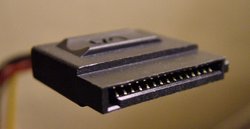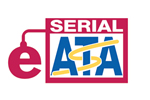Serial ATA
|
|
SATA_Data_Cable.jpg
In computer hardware, Serial ATA (also SATA or S-ATA) is a computer bus primarily designed for transfer of data to and from a hard disk. It is the successor to the legacy Advanced Technology Attachment standard (ATA, also known as IDE). This older technology is now known as Parallel ATA (PATA) to distinguish it from Serial ATA.
First-generation Serial ATA interfaces run at 1.5 gigahertz. Because Serial ATA uses 8B/10B encoding at the physical layer, this results in an actual data transfer rate of 1.2 gigabits per second (Gbit/s), or 150 megabytes per second. This transfer rate is only slightly higher than that provided by the fastest Parallel ATA mode, UDMA-133. However, further increasing PATA bandwidth is somewhat impractical, but the relative simplicity of a serial link and the use of LVDS have allowed Serial ATA to scale easily.
With the release of the Nvidia nForce4 chipset in 2004, the maximum throughput has been doubled to 300 MB/s (2.4 Gbit/s). This increased data rate specification is very widely referred to as "Serial ATA II" ("SATA II"); however, the official website for the SATA standard states that this is a misnomer, SATA II being the name of the organization formed to author the Serial ATA specifications. Indeed, the increased data rate capability was only one of many that were defined by the SATA II committee. The Serial ATA standard organization has since changed names, and is now "The Serial ATA International Organization", or SATA-IO.
SATA-IO plans to further increase the maximum throughput of Serial ATA to 600 MB/s around 2007.
| Contents |
Serial ATA innovations
Physically, the cables used are the most noticeable change from Parallel ATA. The Serial ATA standard defines a data cable using seven conductors and 8 mm wide wafer connectors on each end. SATA cables can be up to 1m (40 inches) long. PATA ribbon cables, in comparison, carry either 40 or 80 conductor wires and are limited to 45cm (18 inches) in length. Serial ATA drops the master/slave shared bus of PATA, giving each device a dedicated cable and dedicated bandwidth. Unlike early PATA connectors, SATA connectors are keyed — it is not possible to install cable connectors upside down.
The Serial ATA standard also specifies a power connector sharply differing from the four-pin Molex connector used by PATA drives and many other computer components. Like the data cable, it is wafer based, but its wider fifteen-pin shape should prevent confusion between the two. The seemingly large number of pins are used to supply three different voltages if necessary — 3.3 V, 5 V, and 12 V. The same physical connections are used on 3.5 inch and 2.5 inch (notebook) hard disks.
Features allowed for by SATA but not by PATA include hot-swapping and native command queueing.
To ease their transition to Serial ATA, many manufacturers have produced drives which use controllers largely identical to those on their PATA drives and include a bridge chip on the logic board. Bridged drives have a SATA connector, may include either or both kinds of power connectors, and generally perform identically to native drives. They may, however, lack support for some SATA-specific features. As of 2004, all major hard drive manufacturers produce either bridged or native SATA drives.
SATA drives may be plugged into Serial Attached SCSI (SAS) controllers and communicate on the same physical cable as native SAS disks. SAS disks however may not be plugged into a SATA controller.
External SATA
Initially SATA was designed as an internal or inside-the-box interface technology, bringing improved performance and new features to internal PC or consumer storage. Creative designers quickly realized the innovative interface could reliably be expanded outside the PC, bringing the same performance and features to external storage needs instead of relying on USB or IEEE 1394 interfaces. Called external SATA or eSATA, customers can now utilize shielded cable lengths up to 2 meters outside the PC to take advantage of the benefits the SATA interface brings to storage. SATA is now out of the box as an external standard, with specifically defined cables, connectors, and signal requirements released as new standards in mid-2004. eSATA provides more performance than existing solutions and is hot pluggable.
Key benefits of eSATA:
- Up to 6 times faster than existing external storage solutions: USB 2.0, & 1394
- Robust and user friendly external connection
- High performance, cost effective expansion storage
- Up to 2 meter shielded cables and connectors
Applications: External Direct Attached Storage for notebooks, desktop, consumer electronics and entry servers.
Many existing external hard drives use USB and/or 1394. These interfaces are not nearly as fast as SATA when compared using peak values, and can compromise drive performance.
USB and 1394 external drives are ATA drives with a bridge chip that translates from the ATA protocol to USB or 1394 protocol used for the connection. These interfaces require en-capsulation or conversion of the transmit data and then de-capsulation after the data is received. This protocol overhead reduces the efficiency of these host buses, increases the host CPU utilization or requires a special chip to off-load the host.
The results of eSATA are dramatic and with no protocol overhead issues as with USB or 1394. The eSATA storage bus delivers as much as 37 times more performance. This ability is perfect for using an array of drives with performance striping behind the eSATA host port.
The typical cable length is 2 meters (6 feet); long enough to reach from a floor mounted PC to a drive placed on the desktop. The compliance is defined in the SATA II: Electrical Specification, as the Gen1m and Gen2m specifications for 1.5 Gb/s and 3.0 Gb/s respectively.
Currently, most PC motherboards do not have an eSATA connector. eSATA is readily enabled, however, through the addition of an eSATA host bus adapter (HBA) or bracket connector for desktop systems or with a Cardbus or Express Card for notebooks. New motherboards introduced in 2005 will start to incorporate e-SATA connectors directly, making the addition of external storage an easy option.
Note: Prior to the final specification for eSATA, there were a number of products designed for external connections of SATA drives. Some of these use the internal SATA connector (easily recognized by the L shaped contact ledge) or even connectors designed for other interface specifications, such as 1394. These products are not eSATA compliant.
See also
External links
- Serial ATA working group specifications (http://www.serialata.org/specifications.asp)
- Tom's Hardware controller tests (http://www.tomshardware.com/storage/20030204/)
- Using serial ATA with Linux (http://www.linuxmafia.com/faq/Hardware/sata.html)
- Serial ATA International Organization (http://www.sata-io.org)de:Serial ATA
es:Serial ATA fr:Serial ATA it:Serial ATA he:Serial ATA ja:シリアルATA pl:SATA pt:SATA sk:Serial ATA fi:SATA sv:Serial ATA


